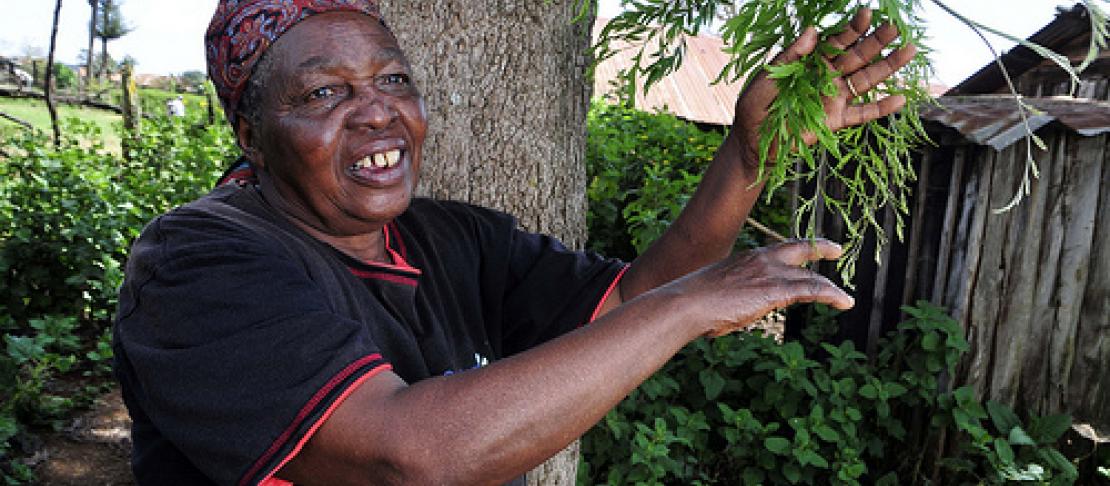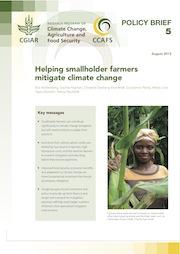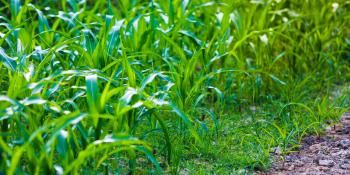Supporting smallholder farmers to mitigate - how do we move forward?

by Lini Wollenberg
Smallholder farmers in developing countries can contribute significantly to climate change mitigation. However, to have any meaningful impact on emissions, thousands if not millions of farmers will need to change their practices. For that to happen interventions will need to be scaled up and a wider range of incentives put into place. While selling carbon credits will work for some farmers, wider mitigation impacts are likely if climate finance and other sources of funds can be channeled through existing financial and technical services to directly support farmers’ needs. How can governments and others give farmers the incentives and support they need to transition to low emission agriculture in ways that are aligned with farmer’s livelihood and food security priorities?
 Mainstreaming climate finance and other sources of funds into credit, insurance, technical support and other farmer services may reach more farmers and have a larger impact than selling carbon credits, according to the new policy brief “Helping smallholder farmers mitigate climate change” produced by the CGIAR Research Program on Climate Change, Agriculture and Food Security (CCAFS) . While carbon markets in agriculture establish important models for performance-based payments and are still in a pilot project phase, their impacts on both farmers’ livelihoods and the climate have been limited thus far by low and uncertain carbon prices, high project development costs, a scarcity of investors and the need for significant upfront finance. The brief examines the costs of mitigation practices, the different kinds of incentives available to farmers, and the conditions needed to enable farmers to mitigate. The analysis was produced in collaboration with the Food and Agriculture Organization (FAO) Mitigation of Climate Change in Agriculture (MICCA) program, drawing from four review papers and an expert workshop jointly organized by CGIAR and FAO programs.
Mainstreaming climate finance and other sources of funds into credit, insurance, technical support and other farmer services may reach more farmers and have a larger impact than selling carbon credits, according to the new policy brief “Helping smallholder farmers mitigate climate change” produced by the CGIAR Research Program on Climate Change, Agriculture and Food Security (CCAFS) . While carbon markets in agriculture establish important models for performance-based payments and are still in a pilot project phase, their impacts on both farmers’ livelihoods and the climate have been limited thus far by low and uncertain carbon prices, high project development costs, a scarcity of investors and the need for significant upfront finance. The brief examines the costs of mitigation practices, the different kinds of incentives available to farmers, and the conditions needed to enable farmers to mitigate. The analysis was produced in collaboration with the Food and Agriculture Organization (FAO) Mitigation of Climate Change in Agriculture (MICCA) program, drawing from four review papers and an expert workshop jointly organized by CGIAR and FAO programs.
Many smallholder farmers in developing countries cannot afford the initial investment needed to adopt new practices. For example, establishing soil and water conservation measures that enable both resilience to climate change and reduce impacts on the climate can cost as much as US$2,000 per hectare. Establishment costs are therefore a key barrier. Financial and technical assistance can be targeted to overcome these barriers, by channeling new funds to more climate-friendly farming practices that help farmers avoid deforestation, plant additional trees, reduce emissions of nitrous oxide and methane, and store carbon in the soil. The real benefit to farmers is improved productivity; once they make the transition to climate-smart farming practices, the additional income from increased yields is often enough to enable farmers to cover maintenance costs of the practice.
Agricultural ministers, policy makers and non-governmental organizations gathered last week in Hanoi, Vietnam, to figure out how to address the drivers and constraints of climate smart agricultural development. The Hunger for Action conference was an opportunity for stakeholders in agricultural development to start mainstreaming climate concerns in their budgets and work plans to make the transition towards more adaptive and low emissions farming happen.
Low emissions will almost certainly be a criterion for how people think of sustainable agriculture in the future. Agricultural development institutions will need to recognize and embrace this, in order to support a transformation towards low-emission farming. Agencies and national governments can make a difference by more intentionally allocating resources to activities that reduce emissions.
Existing institutions for credit, insurance and extension or learning services are already well established in many places and critical to maintaining and enhancing farmers’ options and productivity. A way forward is for these institutions to give preference to practices that support resilient, low-emissions agriculture where they are aligned with farmers’ own priorities, such as efficient use of nitrogen fertilizers; reduced tillage and residue management; alternate wet and drying in irrigated rice; avoided conversion of carbon-rich landscapes such as forests, grasslands and peatlands; agroforestry; and, improved feed and grassland management for livestock. Policy tools such as REDD+, the Clean Development Mechanism and Nationally Appropriate Mitigation Actions (NAMAs) that have sustainable development goals could similarly allocate funds to farmers for their livelihood practices in ways that also reduce emissions as a co-benefit.
This turns the question around: rather than seeking to change farming practices to minimize climate impacts, the goal must be to achieve food security, sustainable agricultural development and adaptation to climate change, while also minimizing emissions where appropriate. Incentives for mitigation should be built into mainstream agricultural investment and policy, together with upfront finance and longer term rewards.
This agricultural transformation is not an intangible goal. It is a goal within reach, but requires support and engagement from relevant decision-makers to be achieved.
Download the policy brief:
Helping smallholder farmers mitigate climate change. By Wollenberg E, Higman S, Seeberg-Elverfeldt C, Neely C, Tapio-Biström ML and Neufeldt H. 2012. CCAFS Policy Brief no. 5. CGIAR Research Program on Climate Change, Agriculture and Food Security (CCAFS)
This blog post was written by Lini Wollenberg, who leads research on Pro-poor Climate Change Mitigation within the CGIAR Research Program on Climate Change, Agriculture and Food Security (CCAFS).


